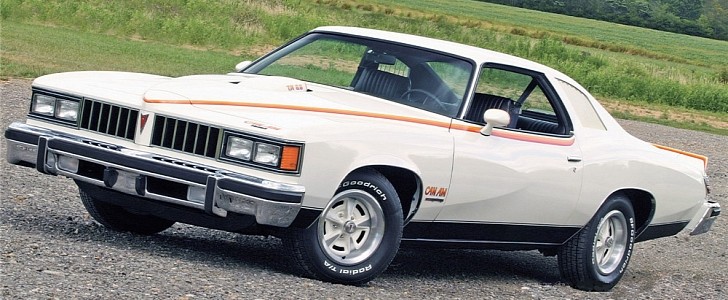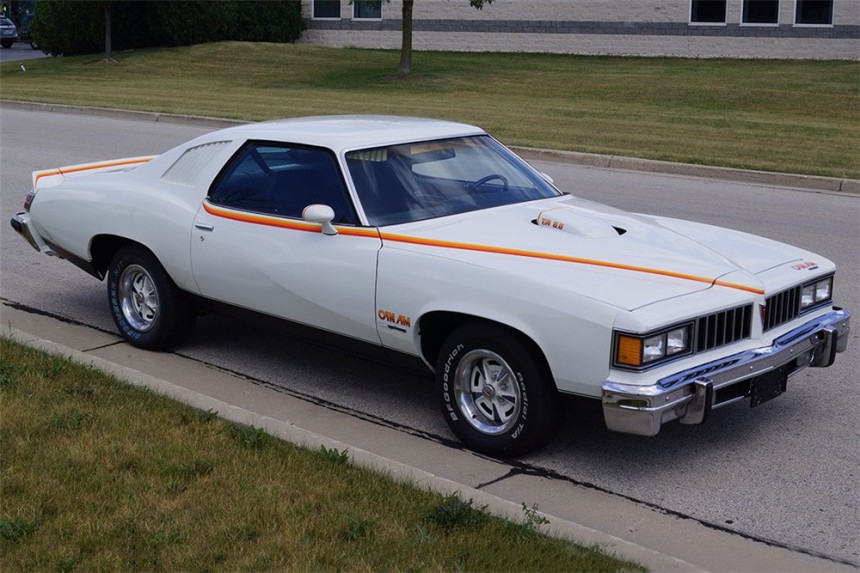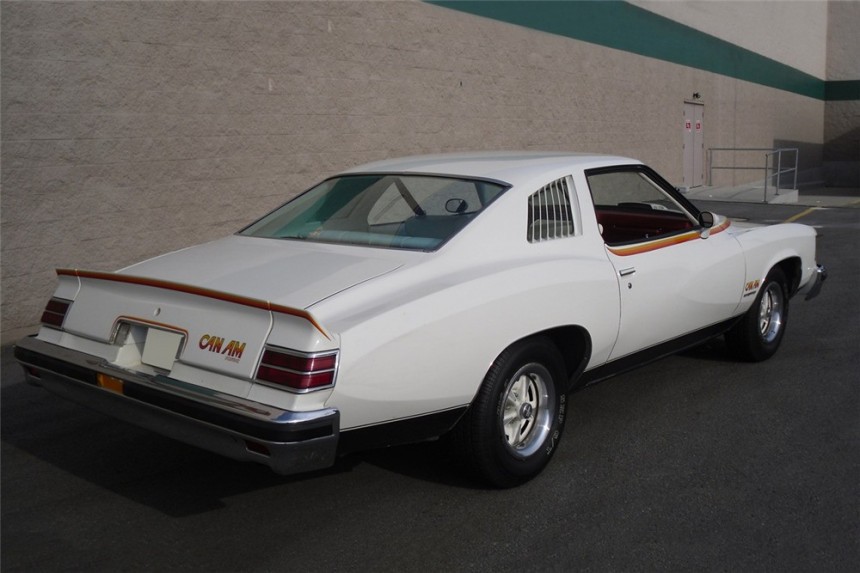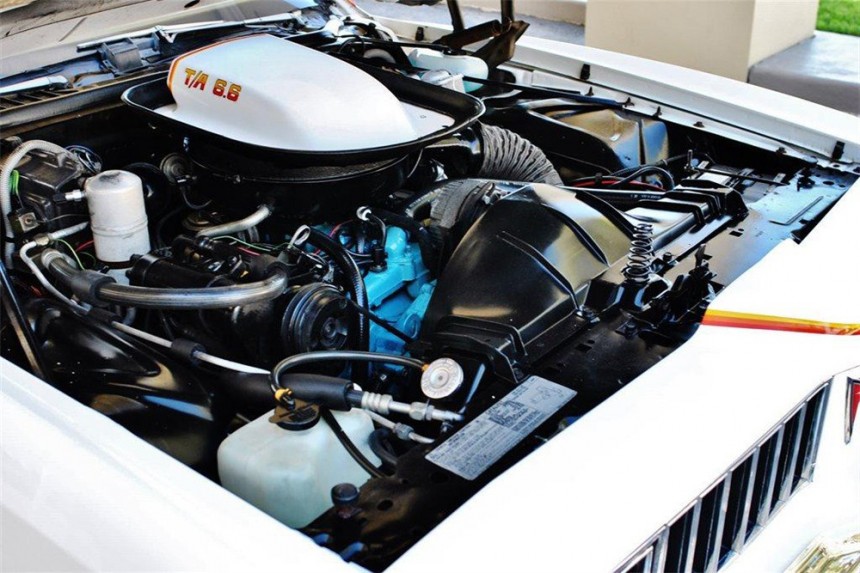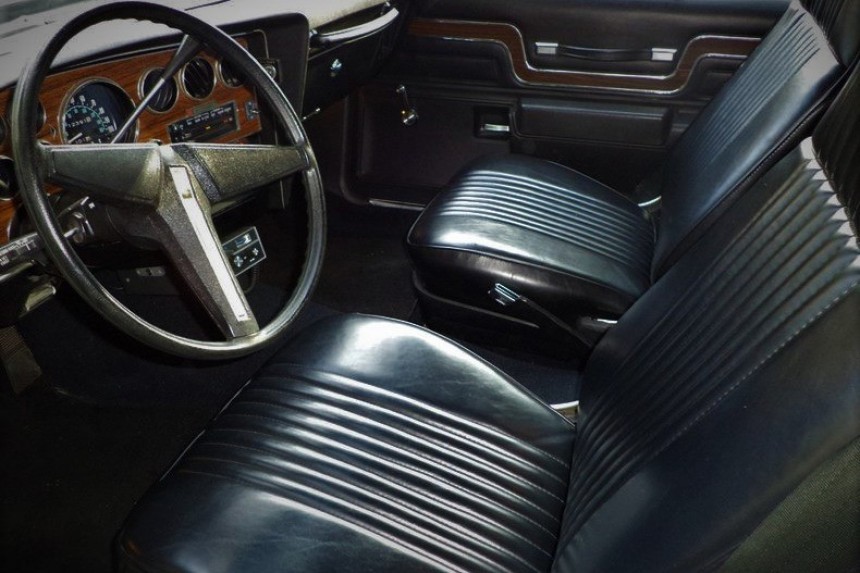Pontiac is often credited for having introduced the first midsize muscle car, the GTO in 1964. Depending on who you ask, that might not be true, but Pontiac was a big player in the muscle car market. And it wasn't only because of the GTO. GM's now-defunct division gave us outstanding performance vehicles like the Catalina, Firebird, LeMans, and Trans Am.
But what you might not know is that Pontiac also built one of the coolest and rarest muscle cars of the mid-to-late 1970s, when the Malaise era had already settled it. It's called the Can Am and it was produced for only six months in 1977.
The brainchild of Jim Wangers, Pontiac's chief marketing manager, the Can Am's main purpose was to revive the spirit of the iconic GTO. A massive success when introduced in 1964, the GTO had lost its charm when the oil crisis hit the U.S. and was reduced to a mundane compact for 1974.
As the nameplate was discontinued after 1974, Pontiac remained active on the pony car market with the Firebird, topped by the Trans Am performance package, but it also had the Le Mans intermediate. But while the Trans Am was selling like hotcakes, the LeMans was trailing behind its GM siblings.
Realizing that Pontiac's muscle car spirit remained alive even after the GTO was sent into the history book, Wangers proposed a performance package for the LeMans. A marketing wizard, Wangers had already created special editions for Detroit-based carmakers while working with Motortown Corporation. Notable examples included the Ford Mustang Cobra II, Dodge Aspen R/T, and the AMC Hornet AMX.
Although built by different companies, these cars had something in common. They harkened back to the golden muscle car era but offered no additional performance compared to the trims they were based on. Wangers wanted to change that with the Pontiac Can Am.
Named after the iconic Canadian-American (Can-Am) racing series, the Can Am was based on the LeMans Sport Coupe. On top of the latter's louvered quarter windows, the Can Am also got the Trans Am's shaker hood scoop plus a ducktail rear spoiler sourced from the Grand Am All-American show car.
All cars were finished in white and rode on Rally II wheels for a nod to the late 1960s, but Wangers also went with tri-tone stripes in orange, yellow, and gold. "Can Am" decals finished in the same colors adorned the front fenders and the trunk lid.
But the centerpiece of the newly-created Can Am was a beefed-up version of Pontiac's W72-series V8 engine. A 400-cubic-inch (6.6-liter) mill introduced to replace the 455-cubic-inch (7.5-liter) in the Trans Am, the W72 generated 200 horsepower, 20 horses more than the similar 400 offered in the LeMans Sport Coupe. It also offered 15 horsepower more than the Oldsmobile-sourced, 403-cubic-inch (6.6-liter) available in the LeMans at the time.
Granted, 200 horsepower was far from impressive when compared to muscle cars from the late 1960s and early 1970s, but it was a solid figure in 1977. For reference, the most powerful Chevrolet Corvette came with 210 horses that year.
Pontiac also build a small batch of Can Ams with the Oldsmobile 403 rated at 185 horsepower, mostly for dealerships in California and high-altitude areas.
The cars were shipped to Motortown, which installed the Can Am aero kit and the shaker hood and applied the decals and accent stripes. This process became an issue when the mold that Motortown used to produce the fiberglass rear spoiler broke after around 1,300 Can Ams were built.
Why didn't they produce a new tool you ask? Well, it seems that some senior Pontiac executives were unhappy that the Can Am was eating into Grand Prix sales. Apparently, the fact that these cars shared some components led Pontiac's upper management to believe that the company lost a Grand Prix for every Can Am built.
With the Grand Prix on track for a record year of almost 290,000 units delivered and with the LeMans set to be redesigned for 1978, Pontiac decided to put an end to the Can Am after only six months in production.
Most sources agree that Motortown put together 1,377 Can Ams, 42 of which were reportedly fitted with the Olds 403 engine. This leaves only 1,335 Can Ams with the 200-horsepower Pontiac 400 V8 out there. On the other hand, Jim Wangers claimed that production was lower than that, at only 1,133 units.
Specific numbers aside, the Pontiac Can Am remains one of the rarest and most intriguing performance cars of the late 1970s. A forgotten Malaise-era muscle car that not only delivered decent power at the time but also featured a cool appearance package. In an era of boring- and cheesy-looking muscle cars, the Can Am was a worthy spiritual successor to the almighty GTO.
The brainchild of Jim Wangers, Pontiac's chief marketing manager, the Can Am's main purpose was to revive the spirit of the iconic GTO. A massive success when introduced in 1964, the GTO had lost its charm when the oil crisis hit the U.S. and was reduced to a mundane compact for 1974.
As the nameplate was discontinued after 1974, Pontiac remained active on the pony car market with the Firebird, topped by the Trans Am performance package, but it also had the Le Mans intermediate. But while the Trans Am was selling like hotcakes, the LeMans was trailing behind its GM siblings.
Although built by different companies, these cars had something in common. They harkened back to the golden muscle car era but offered no additional performance compared to the trims they were based on. Wangers wanted to change that with the Pontiac Can Am.
Named after the iconic Canadian-American (Can-Am) racing series, the Can Am was based on the LeMans Sport Coupe. On top of the latter's louvered quarter windows, the Can Am also got the Trans Am's shaker hood scoop plus a ducktail rear spoiler sourced from the Grand Am All-American show car.
But the centerpiece of the newly-created Can Am was a beefed-up version of Pontiac's W72-series V8 engine. A 400-cubic-inch (6.6-liter) mill introduced to replace the 455-cubic-inch (7.5-liter) in the Trans Am, the W72 generated 200 horsepower, 20 horses more than the similar 400 offered in the LeMans Sport Coupe. It also offered 15 horsepower more than the Oldsmobile-sourced, 403-cubic-inch (6.6-liter) available in the LeMans at the time.
Granted, 200 horsepower was far from impressive when compared to muscle cars from the late 1960s and early 1970s, but it was a solid figure in 1977. For reference, the most powerful Chevrolet Corvette came with 210 horses that year.
The cars were shipped to Motortown, which installed the Can Am aero kit and the shaker hood and applied the decals and accent stripes. This process became an issue when the mold that Motortown used to produce the fiberglass rear spoiler broke after around 1,300 Can Ams were built.
Why didn't they produce a new tool you ask? Well, it seems that some senior Pontiac executives were unhappy that the Can Am was eating into Grand Prix sales. Apparently, the fact that these cars shared some components led Pontiac's upper management to believe that the company lost a Grand Prix for every Can Am built.
Most sources agree that Motortown put together 1,377 Can Ams, 42 of which were reportedly fitted with the Olds 403 engine. This leaves only 1,335 Can Ams with the 200-horsepower Pontiac 400 V8 out there. On the other hand, Jim Wangers claimed that production was lower than that, at only 1,133 units.
Specific numbers aside, the Pontiac Can Am remains one of the rarest and most intriguing performance cars of the late 1970s. A forgotten Malaise-era muscle car that not only delivered decent power at the time but also featured a cool appearance package. In an era of boring- and cheesy-looking muscle cars, the Can Am was a worthy spiritual successor to the almighty GTO.
